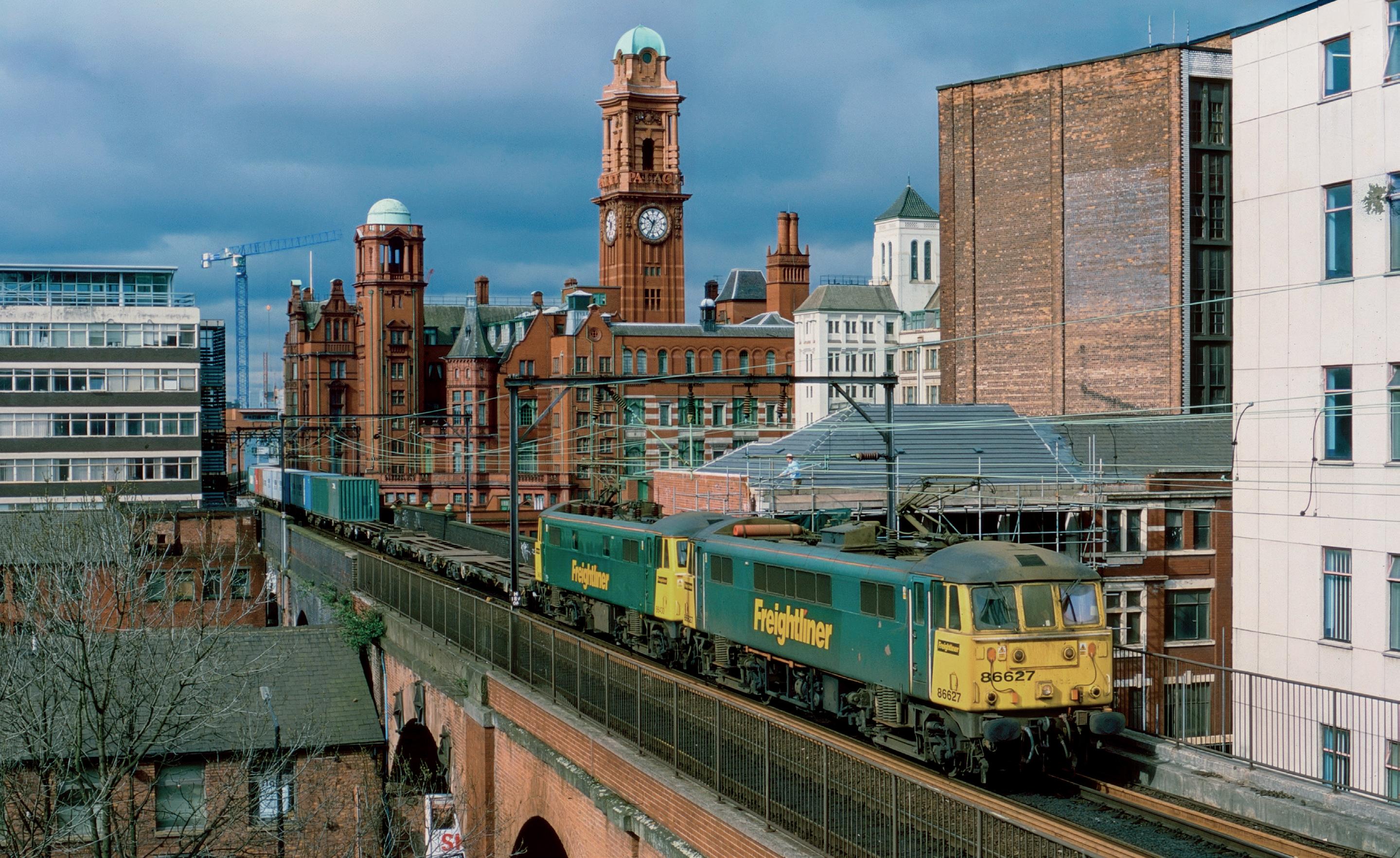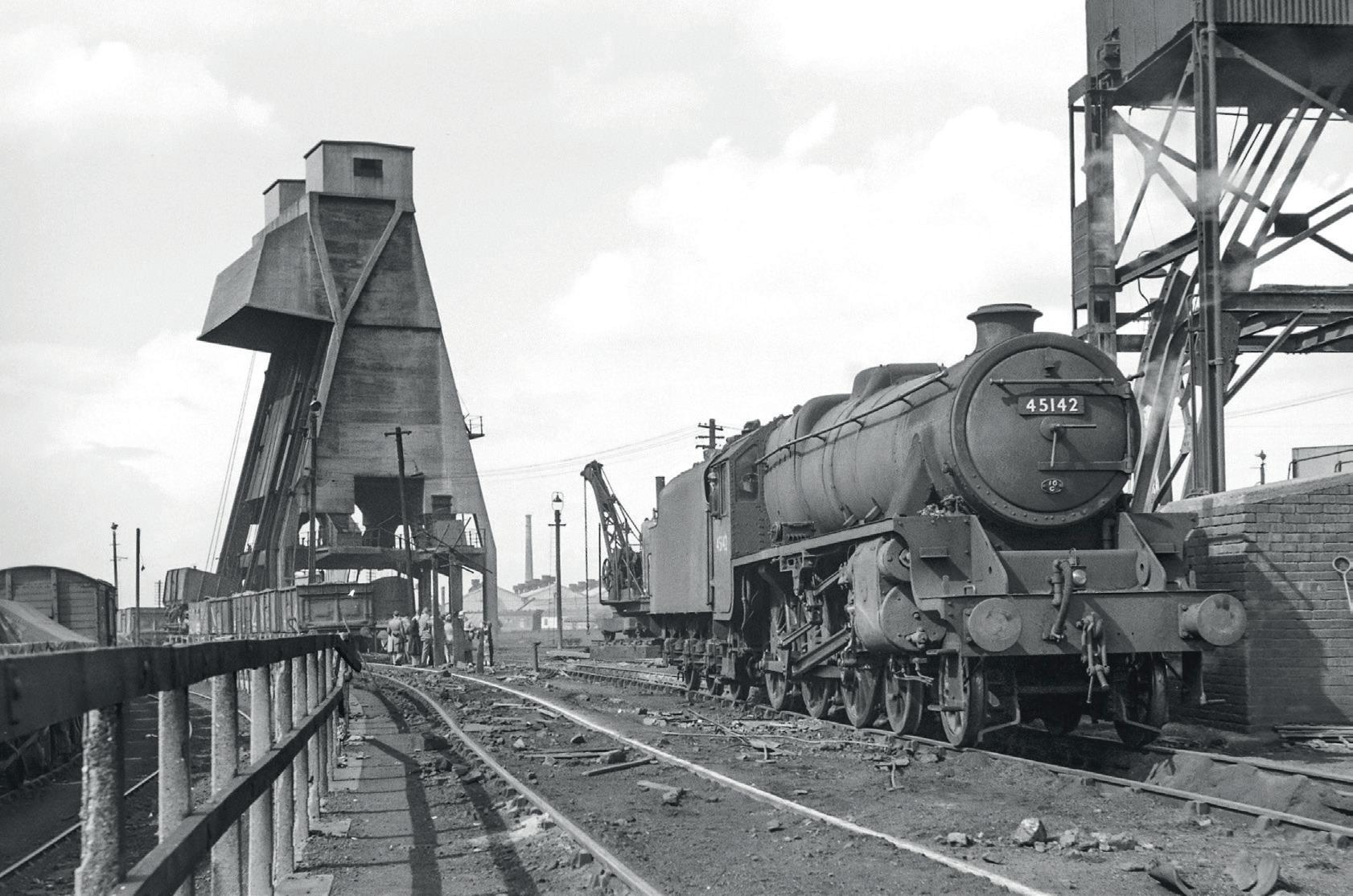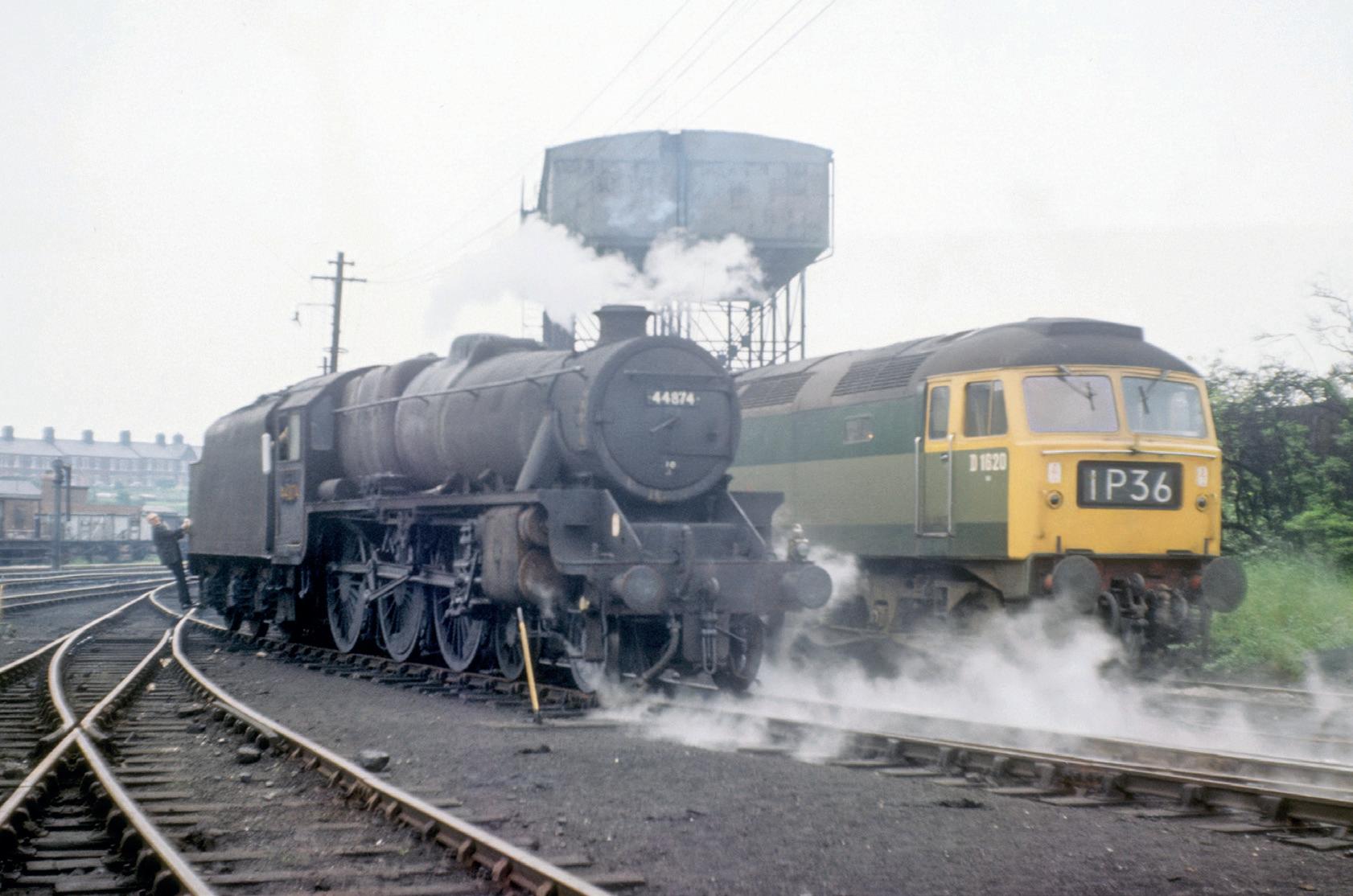

MANCHESTER
Images at and accessible to the Transport Treasury archive

In this undated view, although probably around the 1964/5 period, Stanier Class 5 No 45150 is acting as station pilot as it prepares to shunt the stock of an arriving service out of the platform, a DMU is hiding by the buffer stops in the opposite platform. The locomotive emerged from Armstrong Whitworth’s works in June 1935 as No 5150, it gained its BR number in mid-September 1948 whilst allocated to Northampton. It arrived at Trafford Park depot in midNovember 1964 and was withdrawn at the end of February/early March 1968. (Milepost)

Double-headed Class 86s head a Freightliner service across Oxford Road viaduct on 7 April 2004. The Class 86s were built in 1965/66 to haul services on the electrified West Coast main line, originally designated AL6 they were numbered E3101-E3200 with the change to Class 86 when the Total Operations Processing System (TOPS) classification was introduced; a computer system implemented in the early 1970s, to streamline the process of locomotive, carriage and wagon management on the UK rail network. Freightliner inherited 30 Class 86/6s that had previously been operated by Railfreight Distribution and Rail Express. No 86627 was new from Doncaster Works as E3110 on 19 June 1965, after several refurbishments and renumbering it obtained its current number on 7 October 1998. No 86430 entered traffic the same day, as E3105, and was hired from English, Welsh & Scottish Railways (EWS) when it withdrew its last operational members of the class – 86430, and classmate 86426, were returned to EWS when the need for additional locomotives was reduced and subsequently withdrawn in June 2004 and scrapped. Following withdrawal by Freightliner No 86627 was exported to Bulgaria for further use. (Andrew Royle)

A busy scene at Heaton Mersey in April, unfortunately neither of the locomotives can be positively identified. A Stanier 3MT 2-6-2T is crossing the MR viaduct between Heaton and Cheadle Heath, whilst a Stanier Class 8F is on the CLC’s line between Tiviot Dale and Cheadle. The MR line closed in 1969, local passenger services having ceased in 1967, with the CLC route following in 1980 having lost its local passenger services in the 1960s. (David Horne)
Manchester Victoria station opened on 1 January 1844, marking the start of what would become a long history. It holds the distinction of being the first station in the UK to be named ‘Victoria’, thanks to the special permission granted by the monarch. At its inception, the station was a collaboration between the Manchester & Leeds Railway (M&LR) and the Lancashire & Manchester Railway (L&MR), two key players in Manchester’s railway boom of the 19th century. Located in the heart of Manchester, Victoria station was strategically important for connecting the city to major industrial and urban centres across the north. Originally the station was much smaller than it is today, but it quickly became a hub for passengers and goods moving in and out of the city. Over the years, the station underwent
a series of expansions to accommodate the ever-increasing number of passengers. By the early 20th century, the station boasted an impressive 17 platforms, making it one of the largest and busiest stations in the country serving a mix of local and regional trains, linking Manchester to towns and cities across the north of England. The station has undergone extensive renovations over the years to adapt to modern needs while preserving its historical character. One of the most notable changes occurred in the late 20th century, with the removal of the iconic train shed roofs that once covered the platforms. In place of the old roofs, more practical canopies were added, which have become a recognizable feature of the station.

Right: Part of the facade of Manchester’s Victoria station, listing just some of the destinations that can still be reached by train. (Milepost)

Left: On 6 March 1966 the Williams Deacons Bank Club organised their A4 Tour that took Gresley A4 No 60019 Bittern from Manchester Piccadilly to Crewe (for a Works tour) then onto Derby before returning to Manchester. Bittern, as LNER No 4464 was new to traffic from Doncaster Works on 18 December 1937, renumbered 19 on 16 August 1946 it gained its BR number on 14 October. Following withdrawal from Aberdeen Ferryhill on 5 September 1966 it was privately preserved. (John Tolson)
Right Top: Class 506 DMBS No M59406M is seen at Manchester Piccadilly on 2 February 1985. This was the only vehicle in the unit painted in BR’s blue and grey livery. The original BR repaints were in the otherwise standard blue livery with this later variation starting to appear only a short time before the units were finally withdrawn on 7 December 1984. (John Tolson)

Right Bottom: Class 87 No 87010 was new to traffic from Crewe Works on 15 December 1973, gaining its King Arthur nameplates on 6 June 1978. It is seen here on 2 February 1985 at the head of a London bound service. The 36 Class 87 electrics were introduced into service between 1973-5 and capable of working both passenger and freight services over the West Coast main line – they became the ‘flagship’ locomotives on the route until superseded by the Class 90s, themselves an improvement on the 87s. At privatisation all but one were transferred to Virgin Trains, working until the late 2010s, with some seeing work with other operators. No 87010 was withdrawn from use on Britain’s rail network on 30 September 2008 and was sold to BZK, a Bulgarian railway company along with 16 others of the class. (John Tolson)



SHED
Longsight (LNWR)
The M&BR opened its original 12-stall polygonal roundhouse facility at Longsight in 1842 closure came in 1870 when replaced by the LNWR’s ‘south shed’. The LMS replaced the roof in the early 1930s along with improved access. By the 1950s the shed roof was in a bad way and in 1957 the shed was demolished and replaced by an eight-road shed. Closure to steam took place in January 1961 with the shed used for diesel locomotive and DMU servicing. Class 2P
0-4-4T No 41906 is seen in early BR livery the depot during 1953 where it served from early October 1948 to late March 1955. Although put into service during William Stanier’s time as CME of the LMS the design was clearly that of his predecessor Henry Fowler. The locomotive emerged from Derby Works as No 6406 in December 1932, renumbered to 1906 during 1946. A matter of days short of a 27-year career it was withdrawn from Buxton (LNWR) depot on 28 November 1959. (George C. Bett)
An early electric seen in a workaday condition at Longsight on 23 August 1981. Class 82 No 82001 was constructed by Beyer, Peacock – using electrical equipment supplied by Associated Electrical Industries. It entered traffic at Longsight on 11th July 1960 as No E3047; it carries the cast aluminium ‘arrows of indecision’ on the body side. Apart from two of the class of 10, Nos E3046 and E3055 that were destroyed by fire in the early 1970s, the remainder of the class survived until the 1980s with No 82001 being withdrawn on 17 July 1983. (Bob Wallen)
Patricroft (LNWR)
The first facilities in Patricroft were opened by the LNWR on 1 January 1885 included a coal stage, with a water tank on top, and turntable accompanied by an 8-road shed. An adjacent 10-road shed was opened in 1904. In 1934 a mechanical coaling plant was installed by the LMS as seen here. The depot closed on 1 July 1968 and subsequently demolished. Stanier Class 5MT No 45142 is seen at its home shed of Patricroft sometime during its stay there between late May 1949 to early autumn 1956. Built by Armstrong Whitworth, as LMS No 5142 in May 1935 it would see just shy of 30 years service when it was withdrawn from Crewe South depot in late April 1965. (E. Norman Kneale)

The old and new orders stand alongside at Patricroft depot in early spring 1968. Stanier Class 5 No 44874 emerged from Crewe Works in April 1948 as LMS No 4874. It gained its BR number in early October 1948 whilst allocated to Crewe South, by the date of this photograph it was shedded at Carnforth from where it was withdrawn a few days before the end of main line steam. A little over 20 years later on 17 October 1964, Class 47 No D1620 entered traffic from the same works and was allocated to the Stoke Division when seen alongside No 44874. The Brush Type 4 was renumbered 47039 during February 1974 and again to 47565 on 16 November 1980 following the fitment of eth equipment. It was withdrawn from Bristol Bath Road depot on 1 January 2000. (Bernard Mills)


‘Manchester’ is one of a series of 12 books being released in 2025 showcasing railway works and centres to commemorate ‘Railway 200’.
It was Manchester, the eastern terminus of the Liverpool & Manchester Railway, and the town’s rising industrial interests that were the guiding forces leading to the railway revolution in Britain.
The requirement for cheap and reliable transport of raw materials in and finished products out provided the stimulus for the creation of the railway and, more than 150 years later the development of the new tramway system, was still at the front of developments in the country.

£16.50

